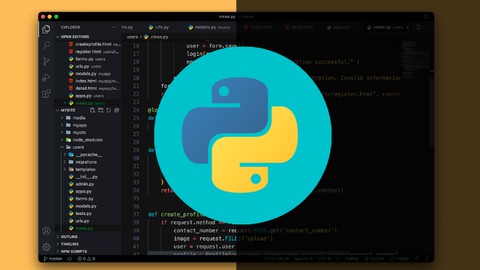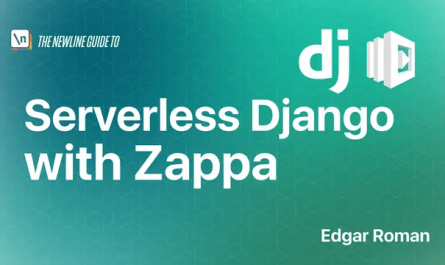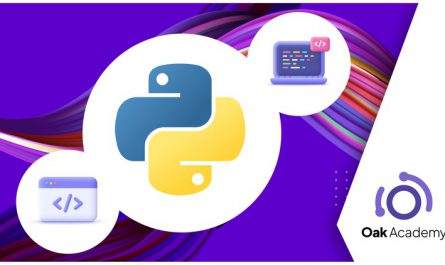
Description
Projects In Python For Intermediate
Here Is What You Get By Enrolling In This Course:
Word-By-Word Explanation: In the entire course, I explain each line of code, without skipping a single line of code.
Awesome Quality Content: Over 10+ hours of HD Videos.
Well Structured & Easy To Learn: Course has been specially designed to make it easy for the students to learn Django starting from a basic level and gradually moving up to advance concepts.
24 X 7 Support: I will always be there to guide you in your journey to become a Django expert.
_________________________________________________________________________
Here Is Everything You Will Learn In This Complete Course:
In this hands-on course, you will learn how to build Python projects using your existing Python skills.
In this course we will build 4 Major apps covering technologies like Django, OpenCV, Implementing Machine Learning Models, Rake NLTK, Tkinter and a lot more.
Here is a brief description of what you will learn in each section of the course:
Section 1: Building A Data Analysis & Visualisation Web App.
Technologies used:
Python : Programming Language
Django : For web based app.
Pandas: For data analysis.
ChartJS: For data visualisation.
Project description:
In this section we will be building a data analytics and visualisation web app. This app will read data from a raw CSV file in a pre-defined format and will generate visualisation charts for us. We will start off by reading and understanding the software requirements specification document and figuring out what exactly needs to be built. This SRS document will mimic the real document which is given by clients to software developers. We then setup the required development environment on our machine required to build the project. As this is a web app, we use Django as a platform to build our entire app, we learn how to download and install Django on our machine and also learn a view basics about Django to get started. We will then learn how to make our Django app read a CSV file submitted by the user and then read data from it. We will learn how to convert the CSV data into a pandas data frame so that the data could be manipulated and analysed. We then render out this data to a HTML page and display it in a tabular format. We also analyse the data using pandas and then feed the analysed data to a Django template and display it in terms of charts for data visualisation. We make use of a library called as ChartJS to display data on our webpage. Hence in this project we learn how multiple technologies like Django, Pandas, ChartJS integrates together to form a working web app.
Section 2: Computer Performance Monitor Using Tkinter.
Technologies used:
Python : Programming language
Tkinter : For building graphical user interface
Psutil : For accessing hardware stats
Speedtest: For getting the internet download, upload speed and ping.
Project description:
In this section we will build a desktop app that monitors CPU & RAM usage in real-time. This project would be built using technologies like Python, Tkinter, psutil and speediest. This app will also be able to calculate the ping, internet download and upload speed as well. We will learn how the psutil library allows us to access the OS level APIs and in turn give us access to the computer performance stats in real time. We will first calculate the CPU usage, then RAM usage and finally the internet speed. We then learn how to represent this information in a desktop app using Tkinter. We build the entire interface for our app using Tkinter and then display all the statistics on a window. We also learn how to use custom fonts, colours and images to give our app a better look and feel.
Section 3: Contextual Advertising Platform.
Technologies used:
Python : Programming language.
Django : For web app.
Requests: For making HTTP request to blog pages.
BeautifulSoup: To parse webpages
RakeNLTK : To find relevant keywords
Project description:
Contextual advertising is a technology that finds our relevant ads from a given blog article to maximise a blog or websites revenue. Contextual advertising is the reason why you see an ad for nike shoes on a fitness related article. In this section we will be building a contextual advertising platform which reads data from any blog who’s URL you pass in, find relevant keywords on that blog and find ads which are relevant to them and all of this is done automatically. First we create a basic Django app that could accept a blog URL, then read all the data on that blog page using the requests library and parse the data using BeautifulSoup. We then feed the parsed data to the rake library which then finds the most relevant and prominent keywords in that blog article and save them. These relevant keywords are then matched with the ads present in our database and gives us back the ads which are most relevant to the blog post. We will also use Tailwind to style up the web app.
Section 4: Gesture Volume Control Software For Mac & Windows.
Technologies used:
Python: Programming language.
OpenCV: To capture webcam input.
Mediapipe: To detect, track hands.
Osascript : To control system volume on Mac.
Pycaw: To control system volume on Windows.
Project description:
This project would be the most interesting one, we will build a gesture volume control software which will allow you to control the volume of your computer by just using two fingers. This software captures your webcam input, detects focal points on your hand like the fingertips and joints and allows us to find the distance between two points. To build this app we use opencv’s python module which allows us to capture video from our web cam, frame-by-frame. Once the video is captured we then use MediaPipe which provides us a set of already trained machine learning models which allows us to detect hands in a live video. We then detect the key points on our hands to detect a gesture and find the distance between tips of two fingers so that we could control system volume. We then make use of osacript on Mac and pycaw on Windows to control the system volume and integrate the two things together so that volume could be controlled by two fingers.
So let’s begin the journey of developing projects with Python
In addition to the Udemy 30-day money back guarantee, you have my personal guarantee that you will love what you learn in this course. If you ever have any questions please feel free to message me directly and I will do my best to get back to you as soon as possible!
_________________________________________________________________________
Make sure to enrol in the course before the price changes.
Take yourself one step closer towards building complex python projects by clicking the “take this course button” now!
Join the journey.
Sincerely,
Ashutosh Pawar
Who this course is for:
- Students who know basic Python and want to build projects using their Python skills
- Students who want to build a portfolio of Python projects to show in job interviews
- Students who don’t just want to learn Python but instead build something meaningful with it
Requirements
- Basic understanding of Python programming language is required
Last Updated 4/2022
Download Links
Direct Download
Projects In Python For Intermediate 2022.zip (3.4 GB) | Mirror


